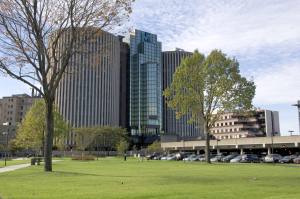1 in 14 Ohio physicians are from Muslim-majority nations
Today Ohio has fewer immigrants, but we still look to immigrants to fill certain roles in our economy. One perhaps surprising one? Ohio does not have enough doctors, particularly in some rural communities and in some lower-paid primary care roles. Immigrants help fill that gap.
We looked at a random sample of 500 Ohio physicians and found that seven percent were born in Muslim-majority nations. One in fourteen Ohio doctors, then, come from countries that could be subjected to a broader version of the Muslim ban that President Trump issued as an executive order in January. The ban was blocked by the Ninth Circuit Court of Appeals in early February, but Trump has vowed to put in place a similar policy.
Suha Abushamma, a Cleveland Clinic physician originally from Sudan, was flying home to Cleveland in late January and was caught in the ban, forced to leave New York’s Kennedy International and return to Saudi Arabia. She’s since returned and been welcomed back by Clinic doctors and patients. But her case made us, researchers at the Case Western Reserve University Center for Health Equity Engagement Education and Research, interested in exploring how a travel ban directed at Muslim-majority countries could affect the physician workforce in Ohio.
Only 1 percent of Ohioans are Muslim. But a travel ban from Muslim-majority countries could hurt many other Ohioans, because such a high share of these immigrants are doctors. Immigrant doctors are particularly helpful in filling physician gaps in underserved rural areas – one in ten Ohioans lives in an area with a doctor shortage. Our sample was too small to measure geography or specialty but recent national analysis found that physicians from other countries were more likely to practice in rural areas and in lower-paying specialties such as internal medicine and psychiatry. (fivethirtyeight.com).
Right now, hospitals are preparing to rank physicians for incoming residency spots. Despite statements decrying the ban and celebrating physician diversity from the American College of Physicians and many hospitals, immigrant doctors are concerned. If medical students and residents fear that they, like Dr. Abushamma, could be detained, sent home, or not welcomed, they will be less likely to come to the US.
We need physicians especially in rural areas and in primary care. Some medical schools, including those in Ohio, offer free or discounted tuition if graduates commit to a period of work in rural or primary care settings. Even this has not solved the problem. Instead, we have relied on international physicians, often requiring redundant training and licensure just to practice where many American-born physicians will not.
Ohio needs doctors. Doctors from Muslim-majority countries have responded to that need. It seems likely that a Trump travel ban will turn that win-win into a loss.
ethodology: Using the database of active Ohio MD licenses from Ohio.gov, we created a random sample of 500 physicians. The Ohio License Center database (license.Ohio.gov), provided country of origin, which we matched with a Pew Research Center Forum on Religion & Public Life identifying Muslim share of population. We found that 7 percent of active physicians (one in fourteen) come from Muslim-majority nations.
Click here to view this blog on Policy Matters Ohio website

